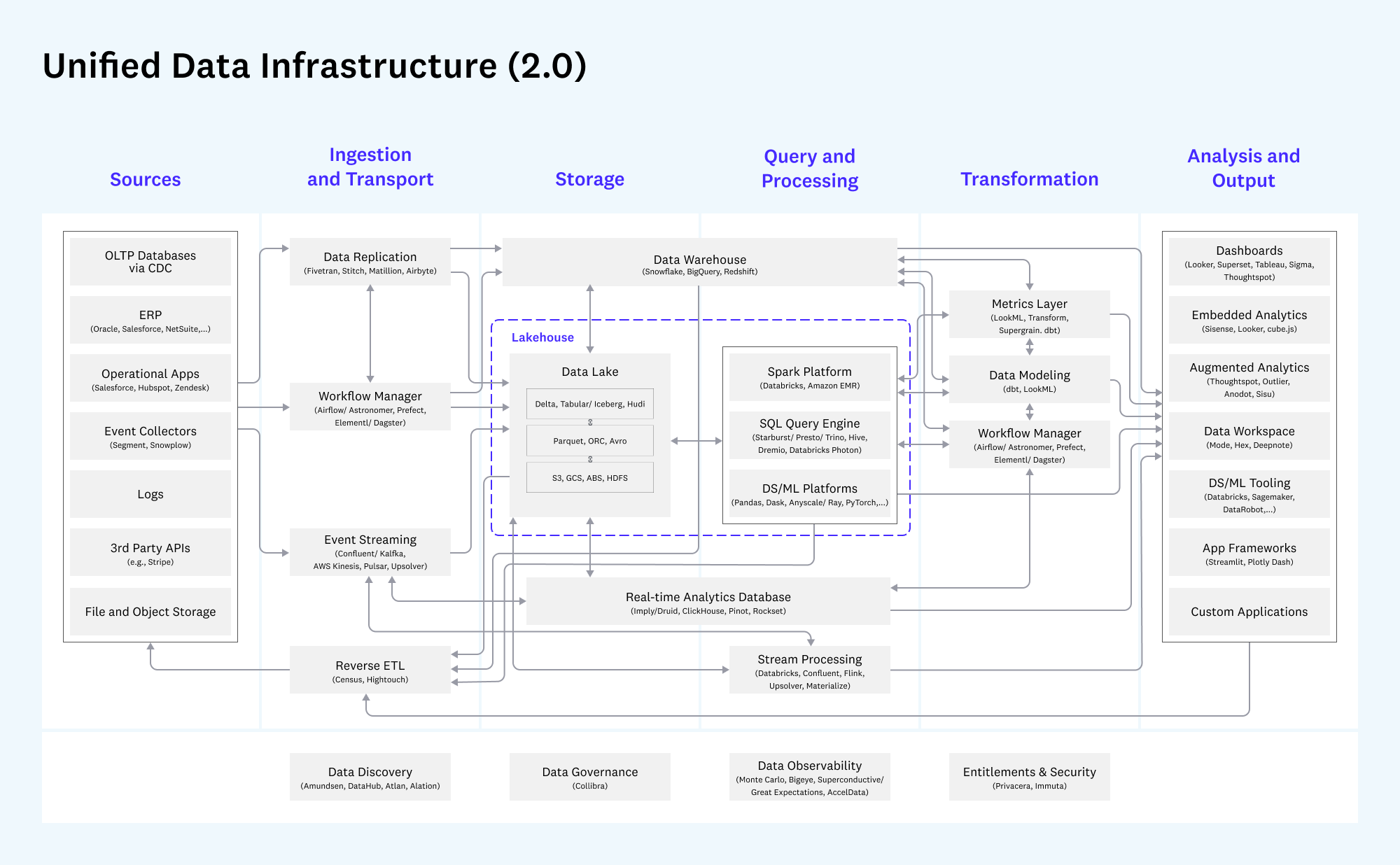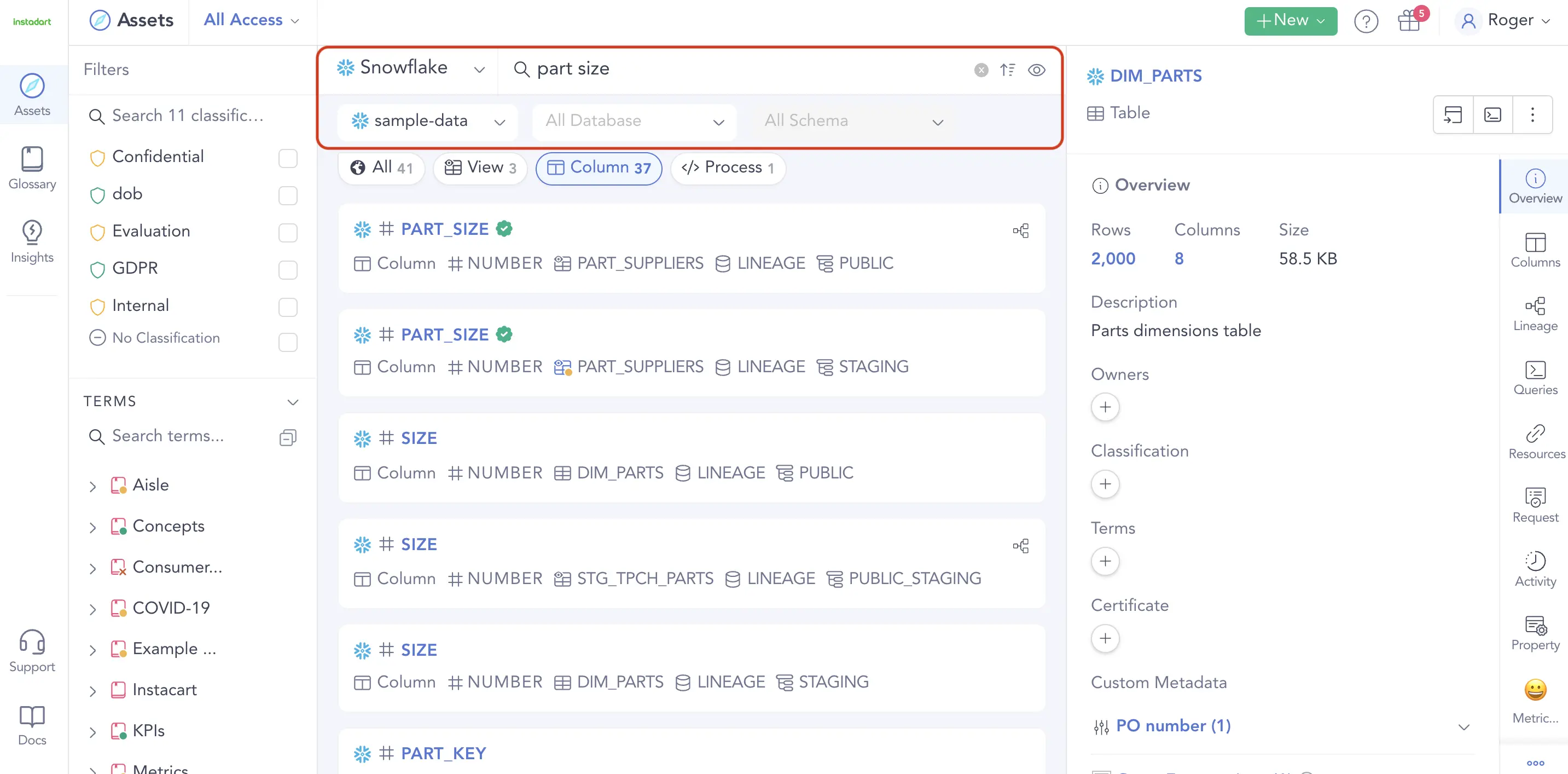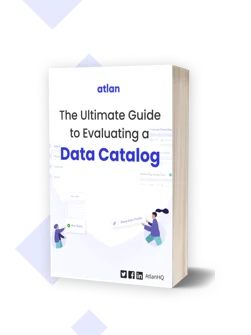Data Catalog vs. Data Warehouse: Differences, and How They Work Together?

Share this article
Data catalog vs. Data warehouse: The difference #
The main difference between a data catalog and a data warehouse is that most modern data platforms use data warehouses to store structured data and data catalogs to find, understand, trust, and use that data.
So, data catalog vs. data warehouse, how do both contribute to the composition of a data stack?
- The data catalog forms the access, context, and collaboration layer
- The data warehouse is part of the storage layer
Together, the data catalog and data warehouse help you store, find, access, interpret, and use the right data as and when you need it.
Table Of Contents #
- Data catalog vs. Data warehouse: The difference
- Why does a data warehouse need a data catalog?
- What comes first: the warehouse or the catalog?
- Data catalog and data warehouse: How do they work together?
- Data catalog: Resource center
- Data warehouse: Resource center
- Data catalog vs. Data Warehouse: Related reads
[Ebook] → Data Catalog 3.0: The Modern Data Stack, Active Metadata & DataOps
Why does a data warehouse need a data catalog? #
A common struggle most organizations face is getting a complete picture of the warehouse data. Mainak Sarkar, EVP of Product & Technology at Tinuiti, pinpoints the challenge:
“No one in the company knows what all is in that warehouse, let alone what datasets are really used, what reports are being actively used by business users.”
So, while a modern data platform is set up around a cloud data warehouse, merely setting it up alone won’t help extract value from data.
Also, as Ralph Kimball mentions in The Data Warehouse Toolkit, Second Edition,
“Data warehouse teams often spend an enormous amount of time talking about, worrying about, and feeling guilty about metadata. Since most developers have a natural aversion to the development and orderly filing of documentation, metadata often gets cut from the project plan despite every- one’s acknowledgment that it is important…. The ultimate goal is to corral, catalog, integrate, and then leverage these disparate varieties of metadata, much like the resources of a library.“
Realizing the real value of data starts with making the context around it searchable and understandable for all kinds of data users in an organization.
So, anyone on the team is able to quickly answer questions like:
- What does each column in a data asset stand for?
- What type of data does the asset contain?
- How is this asset connected to the other assets collected from various sources?
That’s where a modern data catalog (aka a third-generation data catalog) comes into the picture.
a16z’s Modern Data Infrastructure diagram titled “Unified Data Infrastructure (2.0)” illustrates this connection:
- The data warehouse holding things together in the center
- The data catalog layer (split into data discovery, data governance, and data observability) underpinning the full extent of the infrastructure

Unified view of infrastructure and tools in the modern data stack. Source: future.com, a16z
That’s the role of a modern data catalog — to seamlessly integrate data flow across the various components of a modern data infrastructure and make it easy to discover and understand for even non-technical data consumers.
To do that, modern data catalogs rely on active metadata management — a two-way flow of metadata (think reverse ETL but for metadata) from the warehouse to business applications and vice versa.
Metadata is the key to:
- Finding the data you want
- Getting the complete context of that data
- Understanding its lineage and connection to other datasets
- Applying access, storage, and usage rules, i.e., governance
Continuously enriching metadata is crucial to answering the questions mentioned above and realizing the true value of data.

A data catalog crawls and intelligently indexes data assets in a data warehouse for easier discovery. Source: Atlan
What comes first: the warehouse or the catalog? A data stack chicken and egg #
Once organizations are convinced of the importance of both a data warehouse and a data catalog, the next question is:
“Do we build the data warehouse or the data catalog first?”
That’s a classic chicken-and-egg situation for the data stack. The answer: build them simultaneously.
Here’s why. If you wait until the warehouse setup is complete, you’ll have to collect numerous requirements and map all the assets painstakingly — a process that could take months, even years. Even after all that effort, you might not have accounted for all possible scenarios or use cases.
Then comes the enormous knowledge debt to be documented — another seemingly endless task.
On the other hand, if you begin with the catalog, you’ll have to weed through countless data sources before narrowing down on the essential assets. Moreover, you won’t see the results of the cataloging until you’ve ingested, transformed, and made the assets analytics-ready in a warehouse.
That’s why the best way forward is to set up the data catalog while rolling out your data warehouse, which brings us to the next question: “how do they work together?”
Data catalog and data warehouse: How do they work together? #
Generally, data warehouses maintain an internal data catalog. So, your data catalog should extract the system-maintained schemas using SQL queries or API connectors. These schemas contain all the metadata you need to lend granular context to your data assets.
Most data warehouses provide access using a JDBC/ODBC connection, native connectors, or low-level client APIs.
So, the first step is to outline the data sources you need for each use case and document them to decide upon the necessary architectural choices.
At this point, it’s also vital to note that connecting to a data source and pulling metadata puts extra load on that source and affects its read-write performance. So, make sure that you consider these aspects while designing the architecture.
After setting up the architecture, connect the data sources to a modern data catalog. The data catalog will serve as the collaboration, knowledge-capture, and governance layer for your modern data platform that informs your teams about the right assets from the relevant warehouses in real time.
Lastly, optimize the entire process to get the desired results for your pilot use cases, and then set up scalable processes to accommodate more use cases.
Now let’s look at a case study to see the impact of a cloud data warehouse and data catalog on the data team.
A Guide to Building a Business Case for a Data Catalog
Download free ebook
How a fashion retailer leveraged their warehouse and catalog to build a data-centric business #
In 2020, fashion retailer Techstyle began an overhaul of its data stack by moving to Snowflake for its data warehousing needs.
However, when Techstyle started rolling out the new system, they encountered a bottleneck — most of their team couldn’t understand the data or use it independently. In addition, only a few long-standing employees possessed all the knowledge required to extract value from the Snowflake data. The main issue was little documentation for their data.
So, Techstyle embarked on a new mission — documenting the warehouse data using Atlan’s modern data catalog. The process was an iterative and collaborative approach involving all the stakeholders.
As a result, Techstyle is now a data-driven business with a centralized data platform and embedded analysts in each brand team. Analysts embedded in different brand teams across the company can find the data they need and make sense of how to use it. Getting new users up to speed has also become much quicker.
Since Techstyle rolled out its modern data warehouse and used a data catalog to make data discoverable and understandable to everyone, they were able to experience the value of the data being collected by the business.
Are you looking for a data catalog to document and add context to data assets in your data warehouse? — you might want to check out Atlan.
Data catalog: Resource center #
If you’re looking to do further research on data catalogs, here are some must-read resources to help you out:
- The ebook The Third Generation Data Catalog Primer has all you need to know about data catalogs — their history, purpose, and evolution over time.
- The Future of Data Catalogs discusses what to expect from the next stage in the evolution of data catalogs — an essential point of view when evaluating solutions for your team.
- Data Catalog: The Must-Have Tool for Data Leaders in 2024
- Need a data catalog but not sure how to get a buy-in from the other stakeholders in your organization? The Ultimate Guide to Building a Business Case for a Data Catalog will teach you how to demonstrate the ROI of data catalogs as tangible business outcomes.
- Confused about how to find the right data catalog for your team? The Ultimate Guide to Evaluating a Data Catalog is a step-by-step guide to comparing existing catalogs and finding one that suits your needs.
Data warehouse: Resource center #
If you’re researching data warehouses, here are some resources you shouldn’t miss out on:
- Start off with Data Warehouse: Definition, Concept, Components, and Architecture for all you need to know about data warehouses.
- Do a deep dive into Cloud Data Warehouses: Cornerstone of the Modern Data Stack to thoroughly understand cloud data warehouses.
- Unsure about the various technologies that make up the storage layer of the modern data stack? Here’s a brief article to help you understand the difference between a data warehouse, a data lake, and a data lakehouse.
- Keen on investing in a warehouse but not sure which one to pick? The comparison and evaluation guide to cloud warehouse solutions will help you navigate your options and make the right choice per your requirements.
Data catalog vs. Data Warehouse: Related reads #
- What Is a Data Catalog? & Do You Need One?
- Best Alation Alternative: 5 Reasons Why Customers Choose Atlan
- Data catalog benefits: 5 key reasons why you need one
- Open source data catalog software: 5 popular tools to consider in 2025
- Data Catalog vs. Data Dictionary: Definitions, Differences, Benefits & Why Do You Need Them?
- Data Inventory vs. Data Catalog: Definitions, Differences, and Examples
- Data Dictionary vs. Business Glossary: Definitions, Examples & Why Do They Matter?
- Modern Data Catalog: 5 Essential Features and Tool Evaluation Guide
- Data Catalog vs. Data Warehouse: Differences, and How They Work Together?
Share this article












